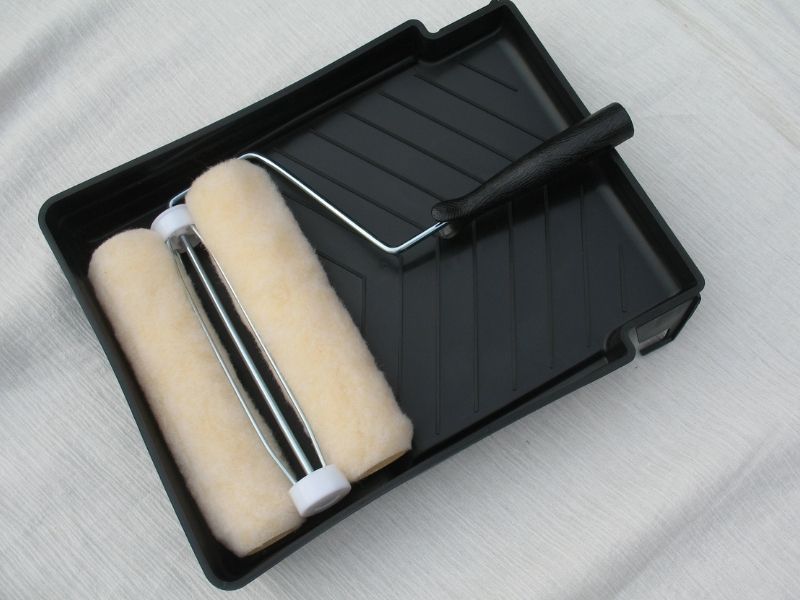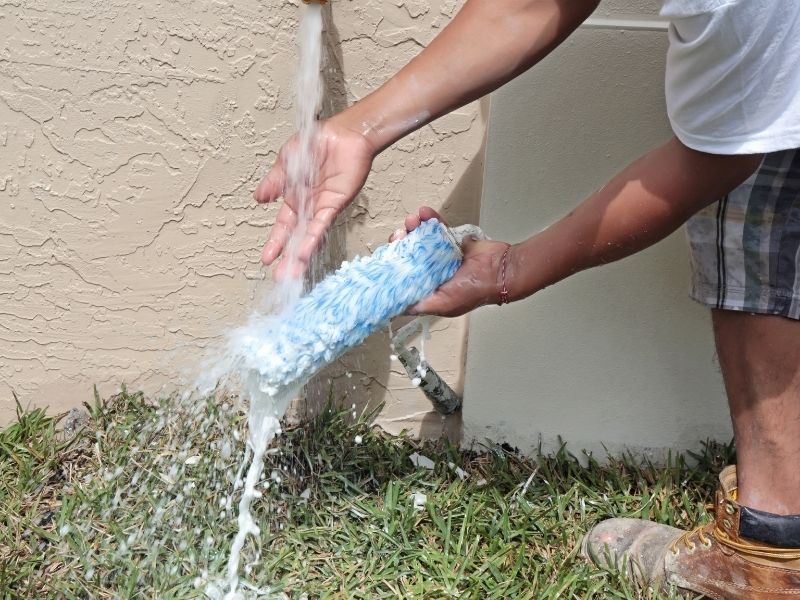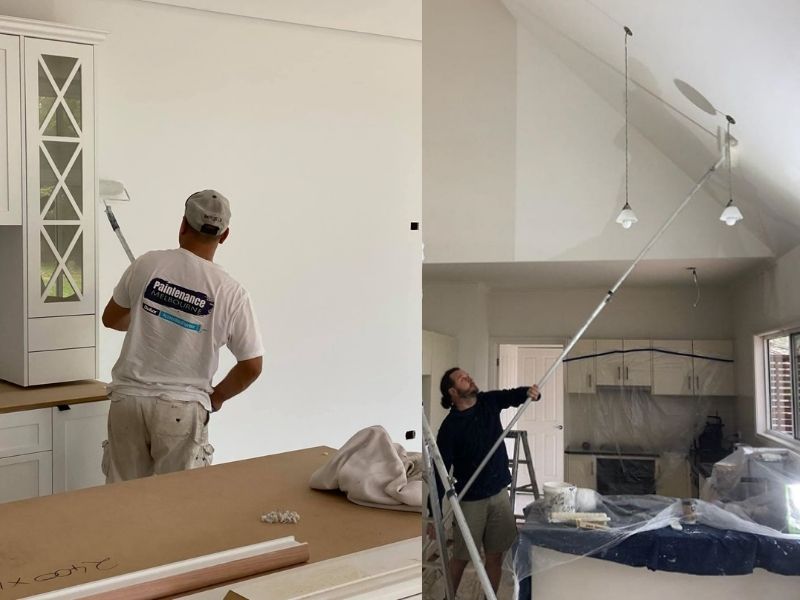Video: How to Paint With a Roller Without Streaks *Currently 39k views
Why Use a Roller?
Rollers are designed to hold lots of paint.
This allows them to cover large areas quicker and easier than using just a paintbrush.
Using a roller is still one of the best ways to apply paint. They’re great for large coverage, and easy to use.
Well, mostly!
Sometimes after a paint job with a roller you can still see streaks or marks. That’s not the finish you were after!
Roller streaks look unprofessional and unsightly.
Roller marks and streaks shouldn’t happen.
If you want to avoid these, there are plenty of tips and tricks.
We’re here to show you how.

Use Quality Equipment
When using a roller, you’ll need the following:
- Tray
- Frame
- Roller cover
- Extension pole.
Always use good quality, well cleaned equipment.
Quality rollers will hold more paint and give a better finish than cheap rollers.
First, start with an even surface.
Most painting mistakes can be prevented by patching holes and fixing dents in the walls and ceilings before you apply your primer.
Before you start using your roller, paint the edges using a brush you are comfortable with.
The more confident and experienced you are, the bigger the brush you could select. Bigger brushes hold more paint and make for a quicker paint job.
Cut-in the edges of one wall at a time.
Paint all edges, corners, and around light switches.
Start with the corner, then bring the line of the paint out from it to make rolling easier.
Once you have finished ‘cutting-in’, with the roller loaded with paint lay it carefully against the wall.
Roll in an upwards direction first, moving across the wall area in a rough ‘W’ pattern. Aim to complete one square metre with each roller load, spreading the paint as evenly as possible.

Ensure You Have The Right Roller For The Job
Use the right size roller for the job.
Use a larger roller for a large surface. Use smaller rollers in areas that are tighter. This will prevent you from limiting your strokes and will cover the surface with more efficiency.
As a general guide:
- 6-8mm nap covers are used for gloss and semi-gloss paints
- 10-12mm nap covers for low sheen and flat paints on walls
- 20-32mm nap covers for most paints on rough surfaces like concrete or textured walls
Rinse new rollers in water (for water-based paints) or turps (for solvent borne paints). This will remove any loose fibres or dust before use.
If your roller handle has been used before, place a drop of oil on the roller handle bearings (i.e., the two plastic end caps). It will make painting much easier.
When using water-based paints, lightly dampen the roller sleeve before use.
Ensure excess water is removed.
The roller should be slightly damp rather than wet to touch.
Your roller tray should also be clean.
Don’t overfill the tray with paint. Loading the roller is more difficult and spillages are more likely.
Once you have poured in the right amount of paint in the tray, roll the roller into the paint to saturate the roller fabric.
The ribbed section of the paint tray will help to squeeze out the excess paint. Make sure your roller gets an equal distribution of paint.
When you roll on the paint, keep a wet edge. This is crucial to all top-quality paint jobs.
Plan Your Painting Job
Work fast enough so that you’re always lapping newly applied paint onto paint that’s still wet.
If you take a break, make sure you stop painting at a natural break in the wall or ceiling, such as a corner.
Place the roller head right inside the paint in your roller tray.
Put a plastic bag around the entire roller tray and seal it. This will keep your roller wet ready for painting when you have finished your break. It will also save you washing your roller unnecessarily.
If you stop for a break in the middle of a wall, for example, and then start painting after this section has dried, you’ll see a lap mark where the two areas join.
To avoid this problem, you need to quickly cover a large area with paint. Then, return to smooth it out.
At times roller marks won’t be visible unless you see the walls in different lighting.
Everything might look great until you open a curtain. Daylight shines on the walls, and suddenly you see streaks.
If this happens, go over these areas with another coat of paint, or use sandpaper to even out the edges.
What To Do if You Have Painting Streaks or Marks
- Apply another coat of paint.
- Paint over areas where you see streaks. Even them out with another coat.
- Be careful not to apply the wrong type of pressure or fail to use enough paint on the roller, which may have created the streaks in the first place.
- Use fine grit sandpaper to even out roller marks.
- Wipe the surface down after you’ve finished with the sandpaper. Then paint over the streaks lightly.

Wash Your Roller When You’ve Finished Painting
Always wash rollers and trays immediately after you’ve finished painting. A clean roller will help prevent streaks on future paint jobs.
When you’ve finished your painting job, roll out as much excess paint from the roller sleeve as you can.
Immerse the roller in a bucket of water. Squeeze through the pile of the roller with your fingers.
Repeat this process in successive buckets of water until clean. Dry the sleeve in the open air.
Pour out soiled water in the garden, not the drain.
It is recommended for you to discard foam sleeves after applying solvent-borne paints. They are time consuming and expensive to clean.
Store roller sleeves upright when they’re clean to avoid flattening the pile.
Prevent Roller Marks by Hiring a Professional Painting Contractor
If you’re one of those resourceful individuals who are keen to tackle their home improvement projects, we salute you.
Painting is one of the most common projects that people take on for themselves.
However, there are obvious differences in the end results of what the average Do-It-Yourself painter can do compared to the professionals.
We applaud the efforts of all DIY painters out there.
We’re also here to assist our customers with painting projects, offering stunning results – without all the headaches.
Paintenance Melbourne uses the right tools for the job, the best quality paints and we employ the techniques that quickly and efficiently gets the job done, on time and on budget.
Is your project something that can be completed in one day?
Let us know how your painting projects are going, and if you need any assistance.
We’d love to hear from you!
Article references and for further reading and information on this topic:
Pro Painters – How to Prevent and Fix Paint Roller Marks After Drying: Five Tips for Beginners
Resene Paints – Painting with Rollers
Reliable Remodeler – Top 10 Painting Tips to Avoid Roller Marks
Dulux – How to Use a Paint Roller



